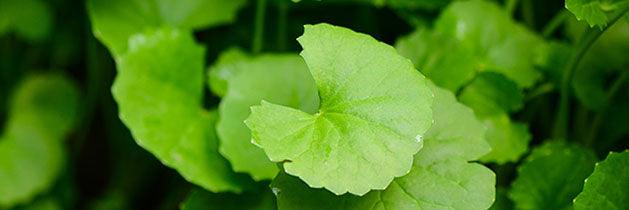QUICK FACTS
Scientific name: Centella asiatica
Other names: Indian pennywort, Asian pennywort, marsh pennywort, brahmamanduki (Hindi), brahmi (Sanskrit), manduka-parni (Sanskrit), also formerly known as Hydrocotyle asiatica
Location: Grows in shady, moist soil throughout tropical Asia, Indonesia, Australia, and southern and central Africa
Known for: Its positive effects on the brain and nervous system
Part Used: Primarily the leaves, although the whole plant can be used
Fun fact: Gotu kola leaf juice is a beverage frequently offered by Indian street vendors
Good for: Brain and nervous system health, immune system support, healthy skin, balanced inflammation, healthy circulation
Key Properties & Actions: Anti-inflammatory, immunomodulatory, mild antimicrobial, nootropic (brain tonic), circulatory stimulant, nervine
What is Gotu Kola?
Gotu kola is a creeping, herbaceous plant that covers the ground with its green, fan-shaped leaves and thin stems. This tropical plant belongs to the Apiacea family, which also includes plants like carrots and parsley.
Gotu Kola prefers the moist, shady soil of river edges, rice paddies, and swampy areas. It can be found growing throughout tropical and subtropical Asian countries, Australia, and parts of Africa.1,2,3
Gotu kola has long been an important medicinal plant of Asia and is now becoming more popular in the West. It has traditionally been used to enhance cognition and support skin health, although it provides a wide variety of other benefits as well.

Modern scientific research has confirmed many of its traditional uses, and today, it is called upon to revitalize the brain, balance mood, support healthy skin, improve circulation, and balance blood sugar.
Note: Gotu kola is sometimes confused with the herb bacopa (Centella asiatica) since both herbs are sometimes referred to as brahmi depending on the information source or medicine tradition. While bacopa is a wonderful herb with some similar uses to gotu kola, the two should not be confused and are not the same plant.
Benefits of Gotu Kola and How It Works
Brain Revitalizer
Gotu kola is arguably most well known for its brain-supportive qualities. It has a long history of being used to enhance cognition and memory. Ayurveda, a traditional medicine system of India, has documented its beneficial effects on memory since ancient times.4
Gotu kola supports the brain through a variety of mechanisms, including balancing the central nervous system, promoting a primary calming neurotransmitter called GABA, combating oxidative stress, and restoring mitochondrial function.5
Its anti-inflammatory and antioxidant properties are mostly responsible for its ability to fight damaging oxidative stress, a common underlying factor in neurodegenerative diseases like Alzheimer’s and Parkinson’s.4
Gotu kola has also been shown to reduce glutamate-induced cognitive deficits and restore proper levels of antioxidants like glutathione.4
In a placebo-controlled, double-blind human clinical trial, improvements in mood and memory were experienced by healthy elderly subjects who received 750 mg of a gotu kola extract for two months. The authors note that the precise mechanism underlying these effects requires further investigation.6
Promotes Balanced Mood
In Eastern cultures, gotu kola has traditionally been used for its calming properties. In India, it is used to decrease anxiety. The extract has demonstrated the ability to modulate GABA, a naturally-occurring amino acid that has a relaxing effect on the brain and nervous system.1,7
In a 2010 human clinical trial, participants were given 500 mg of a gotu kola extract capsule twice daily for 60 days. At the end of the 60-day period, the participants reported a reduction in anxiety and depression symptoms, as well as an improvement in the perception of stress. The authors report that this may be due to gotu kola’s potential to regulate the HPA axis, an endocrine pathway that adapts and responds to stress.8
Supports Healthy Skin
In Asia, gotu kola has been used for hundreds of years to promote the healing of wounds and skin conditions like eczema.9
Asiaticoside, a compound found in gotu kola, can stimulate collagen and the formation of new blood vessels, which is essential in the wound-healing process. It can also balance inflammation, which promotes healthy scar formation.1
In an animal study, both oral and topical administration of a gotu kola extract had beneficial effects on wound healing. The extract was found to increase new cell growth and collagen formation at the wound site.10
Gotu kola is also used to improve blood flow to the skin, decrease cellulite, and reduce varicose and spider veins.3
Improved Circulation
Gotu kola has an affinity for connective tissue, especially the connective tissue that makes up vascular walls. It can strengthen weakened veins and improve circulation from the lower extremities back up to the heart.1
In a double-blind, placebo-controlled study, patients with venous insufficiency of the lower limbs were given gotu kola extract at 120 mg/day, 60mg/day, or a placebo. After two months, the gotu kola extract groups showed improvement in heaviness and edema in the lower limbs compared to the group who received the placebo.11
Blood Sugar Balance
In Tanzania and certain districts of India, gotu kola has traditionally been used to manage blood sugar. This usage is affirmed by modern scientific research that has demonstrated gotu kola’s ability to lower glucose levels.12
A 2014 study attributed this effect to the herb’s capacity to reduce glucose absorption throughout the GI tract. The study also found that consistent use of gotu kola reduced LDL cholesterol.12
Mild Antimicrobial
Although gotu kola may be better known for some of its other functions, this herb possesses mild antimicrobial activity that includes antibacterial and antiviral actions.16, 17
Both in vitro and animal studies have confirmed that gotu kola extract demonstrates antibacterial activity against H. pylori, a common bacteria that, in excess, can lead to infection and damage to the gastrointestinal tract.
Like many bacteria, H. pylori has developed some tolerance to antibiotics, making gut microbiome-balancing herbs like gotu kola even more valuable.16
History & Traditional Use
Gotu kola, or mandukparni in Sanskrit, has a long and rich history of use in the Ayurvedic tradition of medicine. Thousands of years ago, it was listed in Sushruta Samhita, an ancient Sanskrit text on medicine and surgery.1
In Ayurveda, gotu kola is considered a rasayana, a general tonic for increasing longevity. Brahma Rasayana is an important Ayurvedic formulation consisting of gotu kola alongside other herbs and fruits that are made into a paste and combined with warm milk. This comforting beverage is used as a brain tonic and to nourish the nervous system.2

Gotu kola is also an important medicinal herb in China and is sometimes called the “miracle elixir of life,” a flattering nickname in reference to Li Ching-Yun, a long-living herbalist who reportedly used gotu kola regularly.2
In Chinese folk medicine, the tea is used for tonsillitis, colds, jaundice, and more.3
How to Use and Dosing
Gotu kola is most often consumed as capsules or as a tincture. General dosing for standardized powdered extract capsules is 200-400 mg, one to two times a day, and 1-3 mL, one to two times daily for a tincture.
Gotu kola is also occasionally prepared as a tea. To do this, pour 1 cup of freshly boiled water over a teaspoon of the chopped and dried herb. Let infuse for a few minutes up to 15 minutes before straining. Enjoy up to three cups a day.
Beyond its more medicinal preparations, gotu kola is also utilized in a culinary setting. In many Asian countries, it is used as a salad green or juiced fresh. In Ayurvedic tradition, it is infused into ghee, a clarified butter.
To enhance gotu kola’s brain-supportive effects, it can be combined with bacopa, ginkgo, turmeric, ashwagandha, cat’s claw, or lion’s mane mushroom.
Interactions
Individuals taking medications to lower blood glucose (such as metformin) should be aware that gotu kola also helps to reduce blood glucose. in people with elevated blood sugar. However, it will not lower blood sugar in people with normal blood sugar levels as this herb is considered a normalizer rather than an effector. Blood sugar levels should be monitored and dosages adjusted to avoid hypoglycemia.
Always check with your health care practitioner before use if you are taking medications. For more general education on potential interactions between herbs and medications, check out Dr. Bill Rawls’ article: Is it Safe to Take Herbs with My Medications?
Precautions & Side effects
Gotu kola is generally well tolerated and has a low potential for side effects. Because the herb promotes blood flow and stimulates menses, it is best to consult your healthcare provider if using it during pregnancy.
Disclaimer: This information is intended only as general education and should not be substituted for professional medical advice. Any mentioned general dosage options, safety notices, or possible interactions with prescription drugs are for educational purposes only and must be considered in the context of each individual’s health situation and the quality and potency of the product being used. Use this information only as a reference in conjunction with the guidance of a qualified healthcare practitioner.
Want to See the Science? Check Out Our References Below.
1. Gohil KJ, Patel JA, Gajjar AK. Pharmacological Review on Centella asiatica: A Potential Herbal Cure-all. Indian J Pharm Sci. 2010;72(5):546-556. doi:10.4103/0250-474X.78519
2. Engels G. Gotu Kola. American Botanical Council. https://www.herbalgram.org/resources/herbalgram/issues/90/table-of-contents/herbalgram-90-herb-profile-gotu-kola/. Published 2011.
3. Christa S. In: The Essential Guide to Western Botanical Medicine. Arcata, CA: Christa Sinadinos; 2020:331-334.
4. Lokanathan Y, Omar N, Ahmad Puzi NN, Saim A, Hj Idrus R. Recent Updates in Neuroprotective and Neuroregenerative Potential of Centella asiatica. Malays J Med Sci. 2016;23(1):4-14.
5. Sun B, Wu L, Wu Y, et al. Therapeutic Potential of Centella asiatica and Its Triterpenes: A Review. Front Pharmacol. 2020;11:568032. Published 2020 Sep 4. doi:10.3389/fphar.2020.568032
6. Tildesley NT, Kennedy DO, Perry EK, Ballard CG, Wesnes KA, Scholey AB. Positive modulation of mood and cognitive performance following administration of acute doses of Salvia lavandulaefolia essential oil to healthy young volunteers. Physiol Behave. 2005;83(5):699-709. doi:10.1016/j.physbeh.2004.09.010
7. Ceremuga TE, Valdivieso D, Kenner C, et al. Evaluation of the anxiolytic and antidepressant effects of asiatic acid, a compound from Gotu kola or Centella asiatica, in the male Sprague Dawley rat. AANA J. 2015;83(2):91-98.
8. Jana U, Sur TK, Maity LN, Debnath PK, Bhattacharyya D. A clinical study on the management of generalized anxiety disorder with Centella asiatica. Nepal Med Coll J. 2010;12(1):8-11.
9. Bylka W, Znajdek-Awiżeń P, Studzińska-Sroka E, Brzezińska M. Centella asiatica in cosmetology. Postepy Dermatol Alergol. 2013;30(1):46-49. doi:10.5114/pdia.2013.33378
10. Suguna L, Sivakumar P, Chandrakasan G. Effects of Centella asiatica extract on dermal wound healing in rats. Indian J Exp Biol. 1996;34(12):1208-1211.
11. Pointel JP, Boccalon H, Cloarec M, Ledevehat C, Joubert M. Titrated extract of Centella asiatica (TECA) in the treatment of venous insufficiency of the lower limbs. Angiology. 1987;38(1 Pt 1):46-50. doi:10.1177/000331978703800106
12. Kabir AU, Samad MB, D’Costa NM, Akhter F, Ahmed A, Hannan JM. Anti-hyperglycemic activity of Centella asiatica is partly mediated by carbohydrase inhibition and glucose-fiber binding. BMC Complement Altern Med. 2014;14:31. Published 2014 Jan 18. doi:10.1186/1472-6882-14-31
13. Gray NE, Sampath H, Zweig JA, Quinn JF, Soumyanath A. Centella asiatica Attenuates Amyloid-β-Induced Oxidative Stress and Mitochondrial Dysfunction. J Alzheimers Dis. 2015;45(3):933-946. doi:10.3233/JAD-142217
14. Orhan IE. Centella asiatica (L.) Urban: From Traditional Medicine to Modern Medicine with Neuroprotective Potential. Evid Based Complement Alternat Med. 2012;2012:946259. doi:10.1155/2012/946259
15. Cesarone MR, Laurora G, De Sanctis MT, Belcaro G. Attività della Centella asiatica nell’insufficienza venosa [Activity of Centella asiatica in venous insufficiency]. Minerva Cardioangiol. 1992;40(4):137-143.
16. Zheng HM, Choi MJ, Kim JM, Lee KW, Park YH, Lee DH. In vitro and In vivo Anti-Helicobacter pyloriActivities of Centella asiatica Leaf Extract. Prev Nutr Food Sci. 2016;21(3):197-201. doi:10.3746/pnf.2016.21.3.197
17. Yoosook C, Bunyapraphatsara N, Boonyakiat Y, Kantasuk C. Anti-herpes simplex virus activities of crude water extracts of Thai medicinal plants. Phytomedicine. 2000;6(6):411-419. doi:10.1016/S0944-7113(00)80068-9





